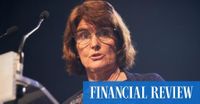The Reserve Bank of Australia (RBA) has recently faced a whirlwind of speculation regarding potential interest rate cuts, particularly in light of the tumultuous trade dynamics influenced by U.S. President Donald Trump's tariff policies. Amidst fluctuating predictions, RBA Governor Michele Bullock has emphasized a cautious approach, asserting that it is "too early" to make definitive calls on interest rates as the economic landscape remains uncertain.
In a speech delivered on April 10, 2025, at the Chief Executive Women’s annual dinner in Melbourne, Bullock addressed the complexities of the current economic climate, particularly the fallout from Trump's recent tariff announcements. These tariffs, which have dramatically increased, especially on Chinese goods, have raised concerns over a potential slowdown in trade between the U.S. and its partners, including Australia.
Following Trump's announcement of a 90-day pause on reciprocal tariffs, which had previously threatened to escalate tensions, the Australian financial markets reacted positively. The S&P/ASX 200 index surged by 4.5%, and the Australian dollar appreciated nearly two cents against the U.S. dollar. This rally, however, did little to assuage the uncertainties surrounding future economic conditions.
"We’re not currently seeing the same degree of impact as previous market events like in 2008, for example," Bullock noted, emphasizing the resilience of the Australian financial system. She stated that the system is "strong and well placed to absorb shocks from abroad," a reassurance that many stakeholders welcomed amid the volatility.
Despite the optimistic market reaction, Deutsche Bank recently revised its expectations regarding interest rates. Initially predicting a significant cut of 50 basis points in May, the bank adjusted its forecast to a more modest reduction of 25 basis points, bringing the cash rate down to 3.85 percent. This change reflects a broader reassessment of the immediate economic outlook in light of Trump's tariff adjustments.
Economist Phil Odonaghoe from Deutsche Bank highlighted that while rate cuts are still anticipated, the urgency for a larger reduction has diminished due to the recent easing of trade tensions. He warned, however, that the tariffs imposed on Chinese goods would likely impact that nation’s economic growth, which in turn could affect Australia.
As the RBA prepares for its next monetary policy meeting scheduled for May 19-20, 2025, Bullock reiterated the bank's focus on its dual mandate of maintaining price stability and full employment. She acknowledged the significant uncertainties that lie ahead and the necessity for patience as the global economic situation evolves.
Moreover, the RBA has signaled that it is cautious about the potential inflationary effects of the new tariffs. Treasury forecasts indicate that Trump’s tax hikes could further exacerbate inflation in Australia, adding another layer of complexity to the RBA's decision-making process.
Chief economist Sally Auld from NAB has expressed concerns about the impact of these developments on both growth and unemployment. NAB forecasts a potential peak in Australia’s jobless rate at 4.4 percent, which is higher than previously anticipated, before a slight reduction to 4.25 percent by 2026. Auld emphasized that the economic landscape has shifted significantly since the RBA last convened in April.
"Our call for a 50 basis-point easing in May reflects the fact that with the real cash rate of 1.3 percent and policy currently restrictive, the RBA needs to play catch up," Auld stated, highlighting the need for a proactive approach amidst rising uncertainties.
As the situation develops, the RBA is also closely monitoring the potential for infrastructure spending stimulus from China, which could provide a buffer against the trade war's adverse effects. The hope is that such measures will sustain economic momentum in Australia, even as trade dynamics shift.
In light of these developments, Treasurer Jim Chalmers has suggested that the recent decline in the Australian dollar could hint at multiple interest rate cuts throughout the year. He indicated that the next cut might be as significant as 50 basis points, should conditions warrant such a move.
Chalmers cautioned against political instability during this critical time, asserting that Australia is better positioned than many of its peers to weather the economic storm. He urged that now is not the time for a change in government, emphasizing the need for continuity in leadership as the country navigates the complexities of international trade and economic policy.
As the RBA and Treasury continue to assess the evolving landscape, stakeholders remain watchful for signs of how these global trade tensions will ultimately shape the Australian economy. The interplay between domestic policy responses and international developments will be crucial in determining the trajectory of interest rates and economic growth in the coming months.
With uncertainty looming, the RBA's cautious stance reflects a broader understanding of the volatile global environment. As Bullock aptly put it, "There are a lot of moving parts. We are bringing all this together to form an objective assessment of what it means for the outlook for domestic activity and inflation here at home." The coming weeks will undoubtedly be pivotal as the RBA navigates these challenges and seeks to foster stability in an unpredictable world.









